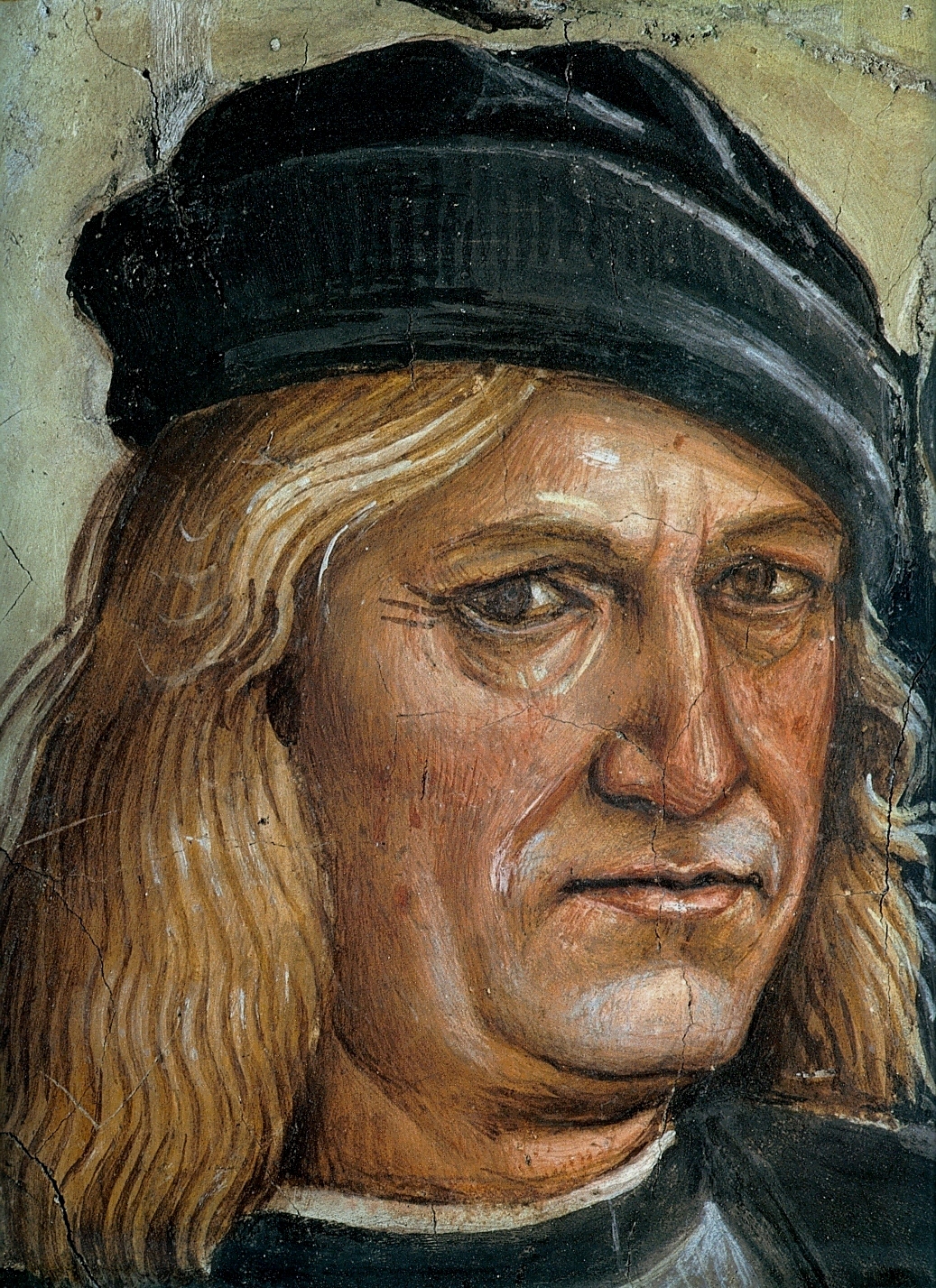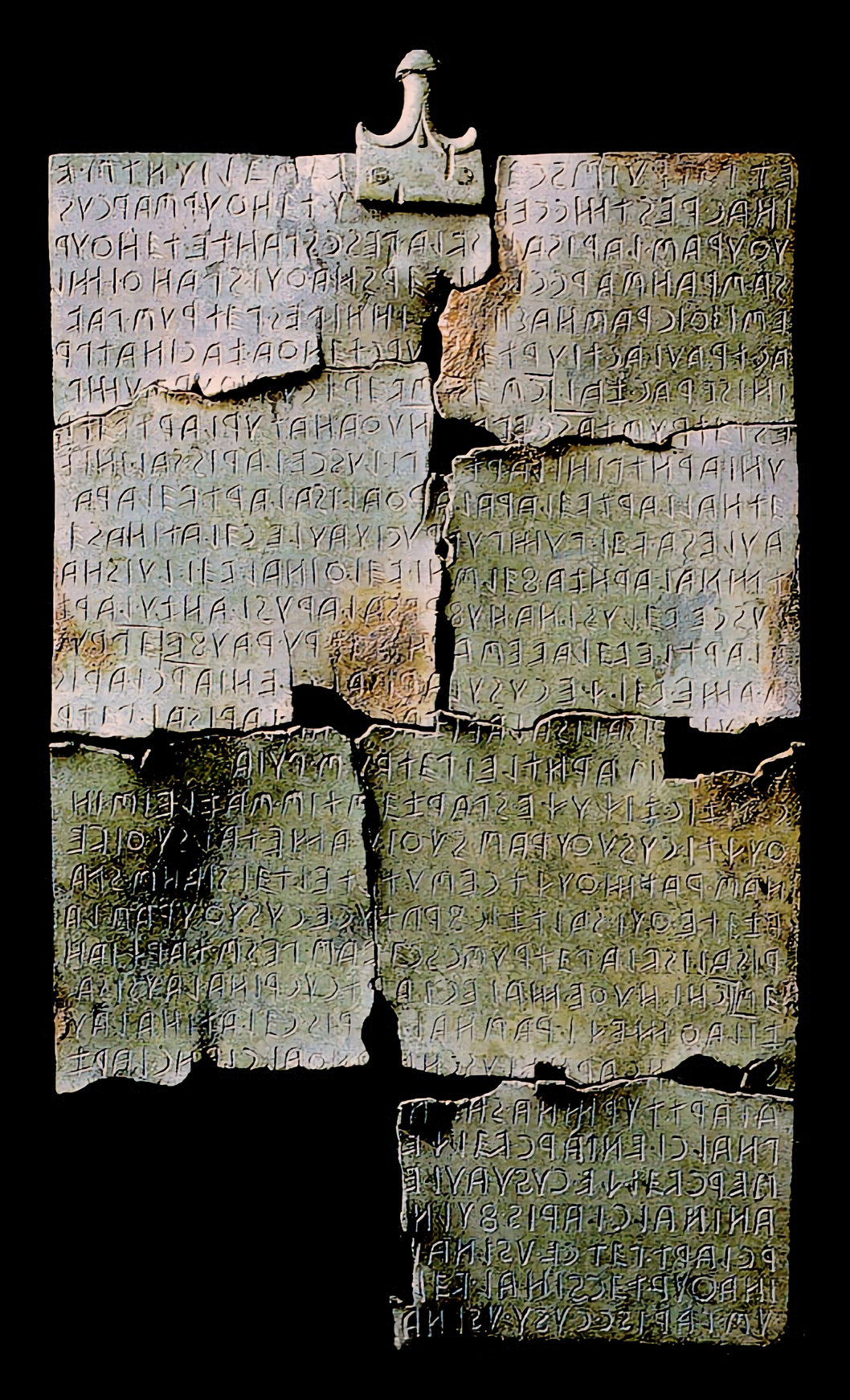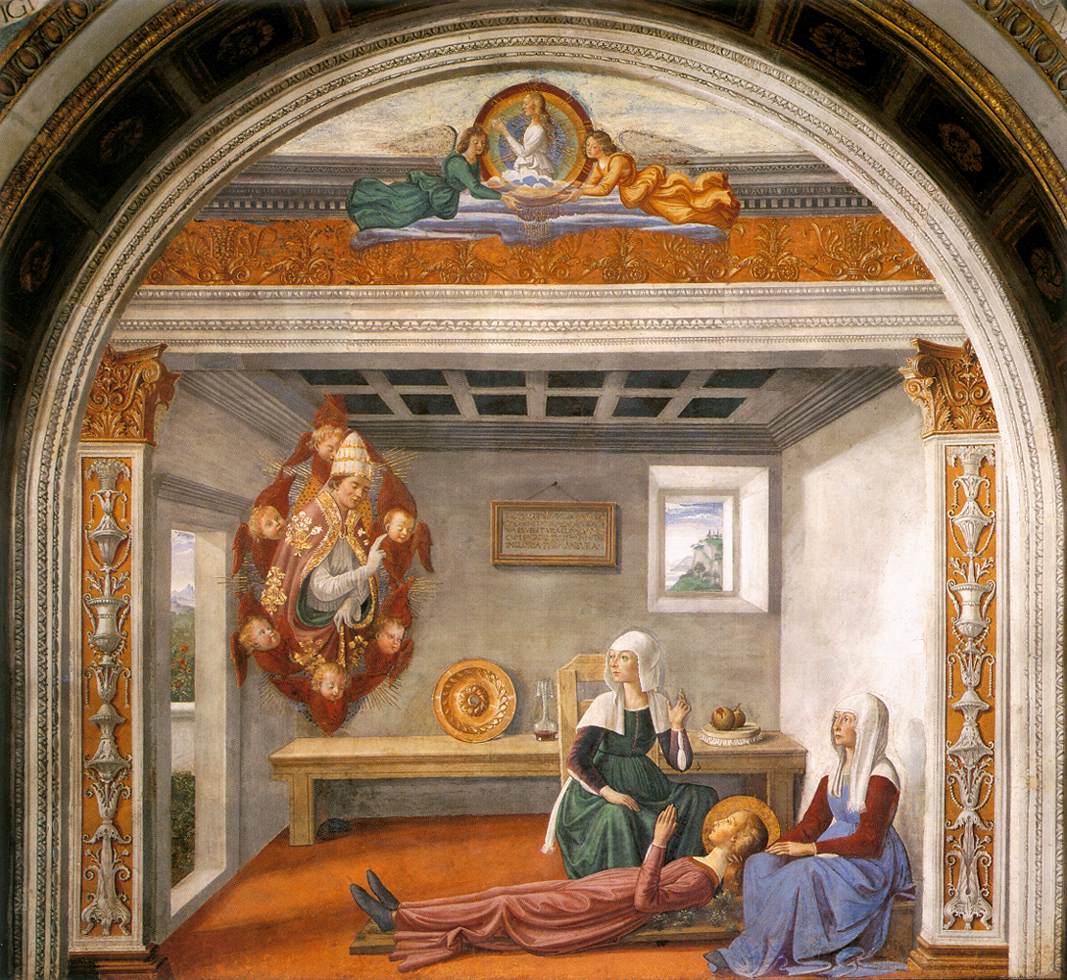|
Virgin Enthroned With Saints (Signorelli)
The ''Virgin Enthroned with Saints'' is a painting by the Italian Renaissance artist Luca Signorelli, dated to 1491 and housed in the Pinacoteca Comunale (Municipal Art Gallery) of Volterra, central Italy. History In 1490-1492 Signorelli was in Volterra, a city under Florentine control, under the patronage of the House of Medici. Aside from this ''Madonna'', he painted an ''Annunciation'', a ''Circumcision of Christ'' and, perhaps, the '' Portrait of Man''. Description The panel's subject is a Holy Conversation, inspired by similar works from the Venetian area, such as Antonello da Messina's San Cassiano Altarpiece and its derivations by Giovanni Bellini and others. Similarities include the green canvas hanging behind Mary's throne, continuing in the broccato carpet at her feet. Also of the same origin is the central cartouche with the artist's signature, derived from Flemish painting and introduced in Italy by Paduan artists. The scene comprises two levels: on the upper one ... [...More Info...] [...Related Items...] OR: [Wikipedia] [Google] [Baidu] |
Luca Signorelli
Luca Signorelli ( – 16 October 1523) was an Italian Renaissance painter from Cortona in Tuscany, who was noted in particular for his ability as a draftsman and his use of foreshortening. His massive frescos of the ''Last Judgment'' (1499–1503) in Orvieto Cathedral are considered his masterpiece. In his early 40s he returned to live in Cortona, after working in Florence, Siena and Rome (1478–84, painting a now lost section of the Sistine Chapel). With an established reputation, he remained based in Cortona for the rest of his life, but often travelled to the cities of the region to fulfill commissions. He was probably trained by Piero della Francesca in Florence, as his cousin Giorgio Vasari wrote, and his Quattrocento style became rather out of date in the new century. Cortona will host a major exhibition in 2023 to celebrate the 500th anniversary of his death. Biography He was born Luca d'Egidio di Ventura in Cortona, Tuscany (some sources call him Luca da Corto ... [...More Info...] [...Related Items...] OR: [Wikipedia] [Google] [Baidu] |
Early Netherlandish Painting
Early Netherlandish painting, traditionally known as the Flemish Primitives, refers to the work of artists active in the Burgundian and Habsburg Netherlands during the 15th- and 16th-century Northern Renaissance period. It flourished especially in the cities of Bruges, Ghent, Mechelen, Leuven, Tournai and Brussels, all in present-day Belgium. The period begins approximately with Robert Campin and Jan van Eyck in the 1420s and lasts at least until the death of Gerard David in 1523,Spronk (1996), 7 although many scholars extend it to the start of the Dutch Revolt in 1566 or 1568–Max J. Friedländer's acclaimed surveys run through Pieter Bruegel the Elder. Early Netherlandish painting coincides with the Early and High Italian Renaissance, but the early period (until about 1500) is seen as an independent artistic evolution, separate from the Renaissance humanism that characterised developments in Italy. Beginning in the 1490s, as increasing numbers of Netherlandish and other Nor ... [...More Info...] [...Related Items...] OR: [Wikipedia] [Google] [Baidu] |
Paintings Of Jerome
Painting is the practice of applying paint, pigment, color or other medium to a solid surface (called the "matrix" or "support"). The medium is commonly applied to the base with a brush, but other implements, such as knives, sponges, and airbrushes, can be used. In art, the term ''painting ''describes both the act and the result of the action (the final work is called "a painting"). The support for paintings includes such surfaces as walls, paper, canvas, wood, glass, lacquer, pottery, leaf, copper and concrete, and the painting may incorporate multiple other materials, including sand, clay, paper, plaster, gold leaf, and even whole objects. Painting is an important form in the visual arts, bringing in elements such as drawing, composition, gesture (as in gestural painting), narration (as in narrative art), and abstraction (as in abstract art). Paintings can be naturalistic and representational (as in still life and landscape painting), photographic, abstract, narrative, s ... [...More Info...] [...Related Items...] OR: [Wikipedia] [Google] [Baidu] |
Paintings Depicting John The Baptist
Painting is the practice of applying paint, pigment, color or other medium to a solid surface (called the "matrix" or "support"). The medium is commonly applied to the base with a brush, but other implements, such as knives, sponges, and airbrushes, can be used. In art, the term ''painting ''describes both the act and the result of the action (the final work is called "a painting"). The support for paintings includes such surfaces as walls, paper, canvas, wood, glass, lacquer, pottery, leaf, copper and concrete, and the painting may incorporate multiple other materials, including sand, clay, paper, plaster, gold leaf, and even whole objects. Painting is an important form in the visual arts, bringing in elements such as drawing, composition, gesture (as in gestural painting), narration (as in narrative art), and abstraction (as in abstract art). Paintings can be naturalistic and representational (as in still life and landscape painting), photographic, abstract, narrative, s ... [...More Info...] [...Related Items...] OR: [Wikipedia] [Google] [Baidu] |
Paintings Of The Madonna And Child By Luca Signorelli
Painting is the practice of applying paint, pigment, color or other medium to a solid surface (called the "matrix" or "support"). The medium is commonly applied to the base with a brush, but other implements, such as knives, sponges, and airbrushes, can be used. In art, the term ''painting ''describes both the act and the result of the action (the final work is called "a painting"). The support for paintings includes such surfaces as walls, paper, canvas, wood, glass, lacquer, pottery, leaf, copper and concrete, and the painting may incorporate multiple other materials, including sand, clay, paper, plaster, gold leaf, and even whole objects. Painting is an important form in the visual arts, bringing in elements such as drawing, composition, gesture (as in gestural painting), narration (as in narrative art), and abstraction (as in abstract art). Paintings can be naturalistic and representational (as in still life and landscape painting), photographic, abstract, narrative, sy ... [...More Info...] [...Related Items...] OR: [Wikipedia] [Google] [Baidu] |
1491 Paintings
Year 1491 ( MCDXCI) was a common year starting on Saturday (link will display the full calendar) of the Julian calendar. Events January–December * January 2 – Alain I of Albret signs the Treaty of Moulins with Charles VIII of France. * March – The French–Breton War resumes. * March 19− 20 – Alain I of Albret captures the Château des ducs de Bretagne for the French. * April 23 – Granada is besieged by the Catholic Monarchs of Spain. Santa Fe, Granada is founded. * May – The war between the Ottoman Empire and the Egyptian Mamluks ends. * May 3 – The ruler of the Kingdom of Kongo, Nkuwu Nzinga, is baptised by Portuguese missionaries, adopting the baptismal name of João I. * May 8 – A solar eclipse takes place over Metz. * June 27 – Louis of Orléans is released by Charles VIII of France after three years of imprisonment. * September – Battle of Vrpile Gulch in southern Croatia: Forces of the Ottoman Empire a ... [...More Info...] [...Related Items...] OR: [Wikipedia] [Google] [Baidu] |
Cortona
Cortona (, ) is a town and ''comune'' in the province of Arezzo, in Tuscany, Italy. It is the main cultural and artistic centre of the Val di Chiana after Arezzo. Toponymy Cortona is derived from Latin Cortōna, and from Etruscan 𐌂𐌖𐌓𐌕𐌖𐌍 (curtun). This may be related to Indo-European *ghortos meaning "enclosed place" and consequently walled city like Latin hortus, German Garten, Italian orto, English yard, and Slavic grad. The name may also be linked to the Phrygian town of Gordium in Anatolia, although the founding myth for the latter is that it was named after founder, King Gordias. However, the Etruscan language is probably a pre-Indo-European language, and therefore if it was named by the Etruscans, an Indo-European etymology is uncertain. The Umbrian language, by contrast, is an Italic language, so if it was named by them, a link to Indo-European roots would be more likely. George Dennis suggests that it was known by many names "Corytus, Croton, Crotona ... [...More Info...] [...Related Items...] OR: [Wikipedia] [Google] [Baidu] |
Centauromachy
The Lapiths (; grc, Λαπίθαι) are a group of legendary people in Greek mythology, whose home was in Thessaly, in the valley of the Peneus and on the mountain Pelion. Mythology Origin The Lapiths were an Aeolian tribe who, like the Myrmidons, were natives of Thessaly. The genealogies make them a kindred people with the centaurs: In one version, Lapithes (Λαπίθης) and Centaurus (Κένταυρος) were said to be twin sons of the god Apollo and the nymph Stilbe, daughter of the river god Peneus. Lapithes was a valiant warrior, but Centaurus was a deformed being who later mated with mares from whom the race of half-man, half-horse centaurs came. Lapithes was the eponymous ancestor of the Lapith people, and his descendants include Lapith warriors and kings, such as Ixion, Pirithous, Caeneus, and Coronus, and the seers Ampycus and his son Mopsus. In the ''Iliad'' the Lapiths send forty crewed ships to join the Greek fleet in the Trojan War, commanded by Polypoetes ... [...More Info...] [...Related Items...] OR: [Wikipedia] [Google] [Baidu] |
Ognissanti, Florence
The chiesa di San Salvatore di Ognissanti or more simply chiesa di Ognissanti (; "Church of All Saints"), is a Franciscan church located on the piazza of the same name in central Florence, region of Tuscany, Italy. Founded by the lay order of the Umiliati, the church was dedicated to all the saints and martyrs, known and unknown. It is the burial place of the famous Early Renaissance painter, Sandro Botticelli. History It was completed originally during the 1250s, but almost completely rebuilt around 1627 in Baroque-style by the architect Bartolomeo Pettirossi. Soon after, a new façade (1637) was erected using designs by Matteo Nigetti, that conserved the glazed terracotta lunette over the doorway, which while resembling the work of Della Robbia, is now attributed to Benedetto Buglioni. Ognissanti was among the first examples of Baroque architecture to penetrate this Renaissance city. Its three reversed orders of pilasters enclose niches and windows with elaborate cornices. To ... [...More Info...] [...Related Items...] OR: [Wikipedia] [Google] [Baidu] |
Domenico Ghirlandaio
Domenico di Tommaso Curradi di Doffo Bigordi (, , ; 2 June 1448 – 11 January 1494), professionally known as Domenico Ghirlandaio, also spelled as Ghirlandajo, was an Italian Renaissance painter born in Florence. Ghirlandaio was part of the so-called "third generation" of the Florentine Renaissance, along with Verrocchio, the Pollaiolo brothers and Sandro Botticelli. Ghirlandaio led a large and efficient workshop that included his brothers Davide Ghirlandaio and Benedetto Ghirlandaio, his brother-in-law Bastiano Mainardi from San Gimignano, and later his son Ridolfo Ghirlandaio. Many apprentices passed through Ghirlandaio's workshop, including the famous Michelangelo. His particular talent lay in his ability to posit depictions of contemporary life and portraits of contemporary people within the context of religious narratives, bringing him great popularity and many large commissions.Toman, Rolf Life and works Early years Ghirlandaio was born Domenico di Tommaso di ... [...More Info...] [...Related Items...] OR: [Wikipedia] [Google] [Baidu] |
John The Baptist
John the Baptist or , , or , ;Wetterau, Bruce. ''World history''. New York: Henry Holt and Company. 1994. syc, ܝܘܿܚܲܢܵܢ ܡܲܥܡܕ݂ܵܢܵܐ, Yoḥanān Maʿmḏānā; he, יוחנן המטביל, Yohanān HaMatbil; la, Ioannes Baptista; cop, ⲓⲱⲁⲛⲛⲏⲥ ⲡⲓⲡⲣⲟⲇⲣⲟⲙⲟⲥ or ; ar, يوحنا المعمدان; myz, ࡉࡅࡄࡀࡍࡀ ࡌࡀࡑࡁࡀࡍࡀ, Iuhana Maṣbana. The name "John" is the Anglicized form, via French, Latin and then Greek, of the Hebrew, "Yochanan", which means "YHWH is gracious"., group="note" ( – ) was a mission preacher active in the area of Jordan River in the early 1st century AD. He is also known as John the Forerunner in Christianity, John the Immerser in some Baptist Christian traditions, and Prophet Yahya in Islam. He is sometimes alternatively referred to as John the Baptiser. John is mentioned by the Roman Jewish historian Josephus and he is revered as a major religious figure Funk, Robert W. & the Jes ... [...More Info...] [...Related Items...] OR: [Wikipedia] [Google] [Baidu] |
Jesus
Jesus, likely from he, יֵשׁוּעַ, translit=Yēšūaʿ, label=Hebrew/Aramaic ( AD 30 or 33), also referred to as Jesus Christ or Jesus of Nazareth (among other names and titles), was a first-century Jewish preacher and religious leader; he is the central figure of Christianity, the world's largest religion. Most Christians believe he is the incarnation of God the Son and the awaited Messiah (the Christ) prophesied in the Hebrew Bible. Virtually all modern scholars of antiquity agree that Jesus existed historically. Research into the historical Jesus has yielded some uncertainty on the historical reliability of the Gospels and on how closely the Jesus portrayed in the New Testament reflects the historical Jesus, as the only detailed records of Jesus' life are contained in the Gospels. Jesus was a Galilean Jew who was circumcised, was baptized by John the Baptist, began his own ministry and was often referred to as "rabbi". Jesus debated with fellow Jews on ho ... [...More Info...] [...Related Items...] OR: [Wikipedia] [Google] [Baidu] |







